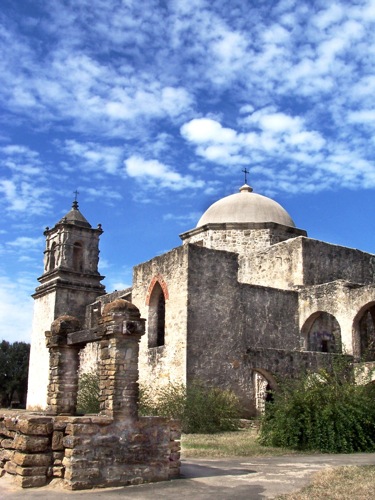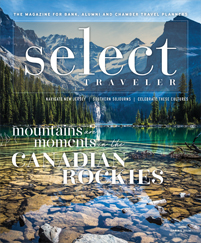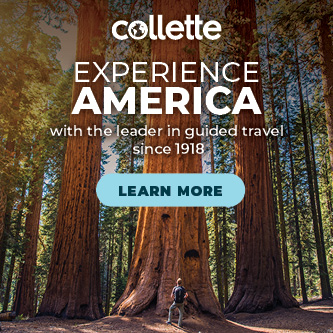
Courtesy San Antonio CVB
San Antonio
Spanish-Mexican influences flow through San Antonio like lifeblood. At the River Walk, cruising under a canopy of twinkling lights on the San Antonio River, groups will find it easy to engage in the city’s heartbeat. Fuchsia and white dianthus, banana trees and palms edge the winding river walkway. Weekend nights, a four-man mariachi band strums lively folk tunes, and dining al fresco occurs year-round.
Central to San Antonio’s culture are its five missions. These buildings stand in their original condition, with only minor repairs, making it easy to envision life during colonial times. Even today, they hold services as active Catholic parishes. And a unique partnership exists between the city and the dioceses, although the National Park Service manages the parkland.
Bike tours can take groups to visit all five missions along the eight-mile Mission Reach trail. The trail adjoins the River Walk for a total of 15 miles of paved pathway that connects the missions with downtown and the northern museums.
The most famous mission in San Antonio — the Alamo — has undergone minimal restoration, which adds to its authenticity. Only one-fifth of the complex’s buildings remain, but the legendary chapel where the Battle of the Alamo’s last shot was fired stands intact. This chapel has several small exhibits, with artifacts such as Davy Crockett’s hunting bag and rifle. A larger museum, located in the 1724 long barrack, chronicles Spanish-Texas history from its earliest beginnings.
Limestone walls loom high above the courtyard at Mission San José, once the largest Spanish mission in Texas. The structure’s frescos date to 1755 and are the oldest in the United States. There’s also a working grist mill and a Baroque chapel filled with fine art. The special “Mariachi Mass” at the mission is led by the Franciscan priests and features a bilingual service, a Spanish choir and mariachi music.
The other three missions date to 1731: Concepción, San Juan and Espada. The last two follow the Franciscan order. Visitors sometimes mistake the clergy for re-enactors since they still wear the traditional brown robes.
Six blocks from the River Walk, tradition continues at the El Mercado Mexican market. Stores stock clothing, crafts and striking Mexican pottery that make perfect souvenirs and gifts. Shoppers can take a break at bustling Mi Tierra restaurant, where for four generations, the Cortez family has served heaping plates of Tex-Mex and homeland specialties from Guadalajara, Mexico.
Galveston
A half-day’s trip east from the Hill Country, Galveston is Texas’ version of a Gulf Coast getaway destination. Galveston Island Tours provides a variety of options for groups that want to explore, including custom-designed excursions that provide insight into the island. An affiliate of the Galveston Historical Foundation, the company takes groups downtown and to the East End Historical District, where groups can see more than 30 tree sculptures that were created from oak trees destroyed by Hurricane Ike.
“The Historical Foundation has a major role in preserving Galveston’s buildings,” said Leah Cast, public relations manager at the Galveston Island Convention and Visitors Bureau. “They put a lot of research into their tours and have a unique perspective of the island, its history and architecture.”
Moody Gardens, Galveston’s most popular group destination, focuses on conservation, recreation and preservation of nature and animals. Within its pyramid-shaped buildings live rescued animals who can no longer survive in the wild.
The Aquarium Pyramid, the complex’s largest building, contains 1.5 million gallons of water and more than 10,000 marine animals from the world’s four ocean environments. The South Atlantic exhibit introduces visitors to six species of penguins. The North Pacific area houses playful fur seals and Squirt, a blind sea lion. A spectacular kelp forest showcases the rich and diverse underwater world from Northern California to the Gulf of Alaska.
The South Pacific exhibit features coral reefs and underwater viewing. The Caribbean exhibit houses sharks, sea turtles, eels and thousands of tropical fish.The 10-story glass Rainforest Pyramid underwent a $25 million renovation and reopened May 2011. More than 1,000 species of endangered plants and animals live there. Free-roaming Saki monkeys and colorful macaws delight visitors.
The Discovery Pyramid features displays about animal and marine life. It also houses the Ridefilm Theater. The Ridefilm surrounds passengers with a seamless 180-degree wraparound screen, where high-quality images and sound make riders part of the action. The 3-D screen, one of Texas’ largest, shows films that highlight marine and plant life, as well as current Holllywood movies. The 4-D special effects include wind, smoke, mist, leg ticklers, seat buzzers and surround sound.
The complex’s historic Colonel Paddlewheel Boat gives one-hour cruises through the nearby bayou. The 1800s-style Paddlewheeler features two rooms with large dance floors that can be booked for groups. Monthly dinner cruises include a buffet, nonstop dancing and a cash bar.









